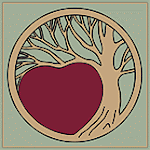
No, I didn’t kill the carving, but I did hang it out to dry. The Gaia is now ready for the oiling phase. For extra height, I modified the jig I use to stain frame pieces for the tree carvings. I also placed a staple on the underside of the carving, just as I do when I’m oiling a tree carving. This allows the carving to receive oil on all sides simultaneously.
The reason it is hanging upside down is so the oil will not pool in the crevices or tight V places where the limbs meet.
I prefer to use Danish oil because it really soaks into the wood and will give the wood a light honey-brown color. The first two coats can be applied the same day. I use a small artist’s paint brush to apply the oil. (Preferably a brush specifically made for oil paints.) Since the carving has been sanded so smooth, it’s like painting on glass, which is a far different experience than oiling one of the tree carvings.
To see more carvings, please visit the
Heartwood Art site.








